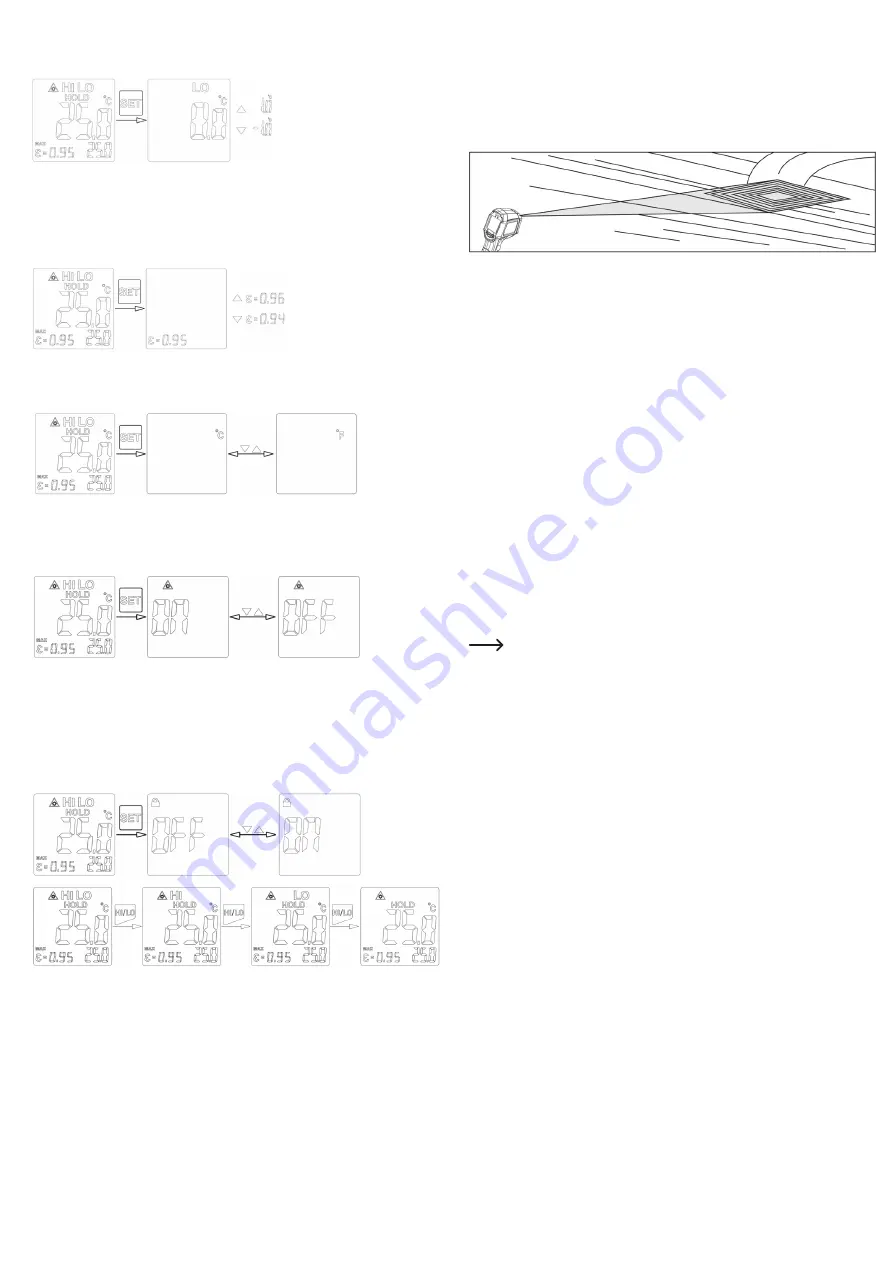
f) Lower limit (alarm)
Press the SET button to enter the upper limit (High) menu (see below). Change the value as
described in the section.
g) Adjustment of emission levels
Depending on the measured surface you will need to set the appropriate emission level (Epsilon
0.01 ... 1.0) in the device for metering. Based on that, the temperature will be calculated from the
measured values. Use the Up/Down buttons (in the main menu) to change the emission level in
0.01 steps. There is no need to press any button; the device will save this value and exit the input
mask after 5 seconds.
h) Setting the units
Press the SET button several times until the unit (°C or °F) appears on the display. Use the MODE
button to toggle between units. The setting will exit automatically after 5 seconds.
i) Turning the laser on and off
Press the SET button until the LASER icon appears on the display. Use the MODE button to turn
the laser on or off.
The laser function enabled is also shown in the main menu.
j) Limit values - Turning the alarm on and off
• Press the HI/LO button to turn the alarm on or off.
• HI/LO: both alarms are on
• HI: the upper limit alarm is on
• LO: the lower limit alarm is on
• If the measured value is not within the limit values, warning lights will flash up red above the
display.
Measuring
Direct the measuring hole (7) perpendicular to the object to be measured. Make sure the object
to be measured is not smaller than the IR-measuring surface of the device. Press the mea-
surement button (9) and hold it down. The measured value (1B) is shown in the display. The
displayed value corresponds with the average surface temperature of the IR-measuring surface.
During the reading „HOLD“ (1C) disappears. After releasing the measurement button (9), the
last measured value will be displayed for approx. 1 minute for a better readability. „HOLD“ (1D)
will also be displayed.
• About 1 minute after releasing the measurement button (4), the device turns off automatically.
“OFF” is shown briefly on the display before the device switches off.
• If the temperature measuring range is exceeded, „Hi“ is displayed, if the values are below the
temperature measuring range, „Lo“ is displayed.
• To determine the warmest spot on the object to be measured, move the measuring device over
the surfaces of the object covering all areas and pressing and holding down the measuring
button (9). The highest temperature measured will be displayed as maximum temperature on
the bottom left.
• Shiny surfaces affect the measured result. To compensate, the shiny part of the surface can
be covered with adhesive tape or matt black paint. The device cannot take measurements
through transparent surfaces such as glass. Instead, it measures the surface temperature of
the glass.
• Longer measurements of high temperatures, with close measuring distance, lead to self-hea-
ting of the measuring device and thus to inaccurate measurements. In order to obtain exact
measured values, remember the following rule of thumb: The higher the temperature, the
greater the measuring distance and the shorter the measuring time.
Maintenance and cleaning
The product does not require any maintenance. You should never take it apart.
Open the compartment to change the battery. Remove the screw with a slot screwdriver. Re-
place the battery. Should the contacts not fit easily, check whether polarity and battery type are
correct. Secure the battery cover to protect against water and dust.
Only a specialist or specialist workshop should carry out repairs otherwise you would risk ruining
the product; Apart from this, CE approval will become void as well as the guarantee/warranty.
Before you clean the lens, switch off the device - especially the laser. If necessary, the
rechargeable battery must be disconnected from the charger.
Clean the product only with a soft, clean and fuzz-free cloth. Do not use cleaning agents as they
may corrode the plastic housing and wear off the labelling.
a) Cleaning of the lens
Remove loose particles with clean compressed air (hand pump from a specialist shop for lenses)
and wipe off remaining residues with a fine lens brush. Clean the surface with a lens cleaning
cloth or a clean, soft, lint-free cloth. To remove fingerprints and other fat residues, the cloth can
be moistened with water or lens cleaning solution. Do not use any acidic, alcoholic or other sol-
vents or rough, linty cloth to clean the lens. Avoid applying too much pressure during cleaning.
b) Cleaning the housing
Do not use scouring, chemical or aggressive cleaning agents such as benzene, alcohol or the
like for cleaning. These might attack the surface of the device. Furthermore, the fumes are explo-
sive and hazardous to your health. Moreover, you should not use sharp-edged tools, screwdri-
vers, metal brushes or similar implements for cleaning.
Dust can be removed using a clean, soft brush and a vacuum cleaner.
















